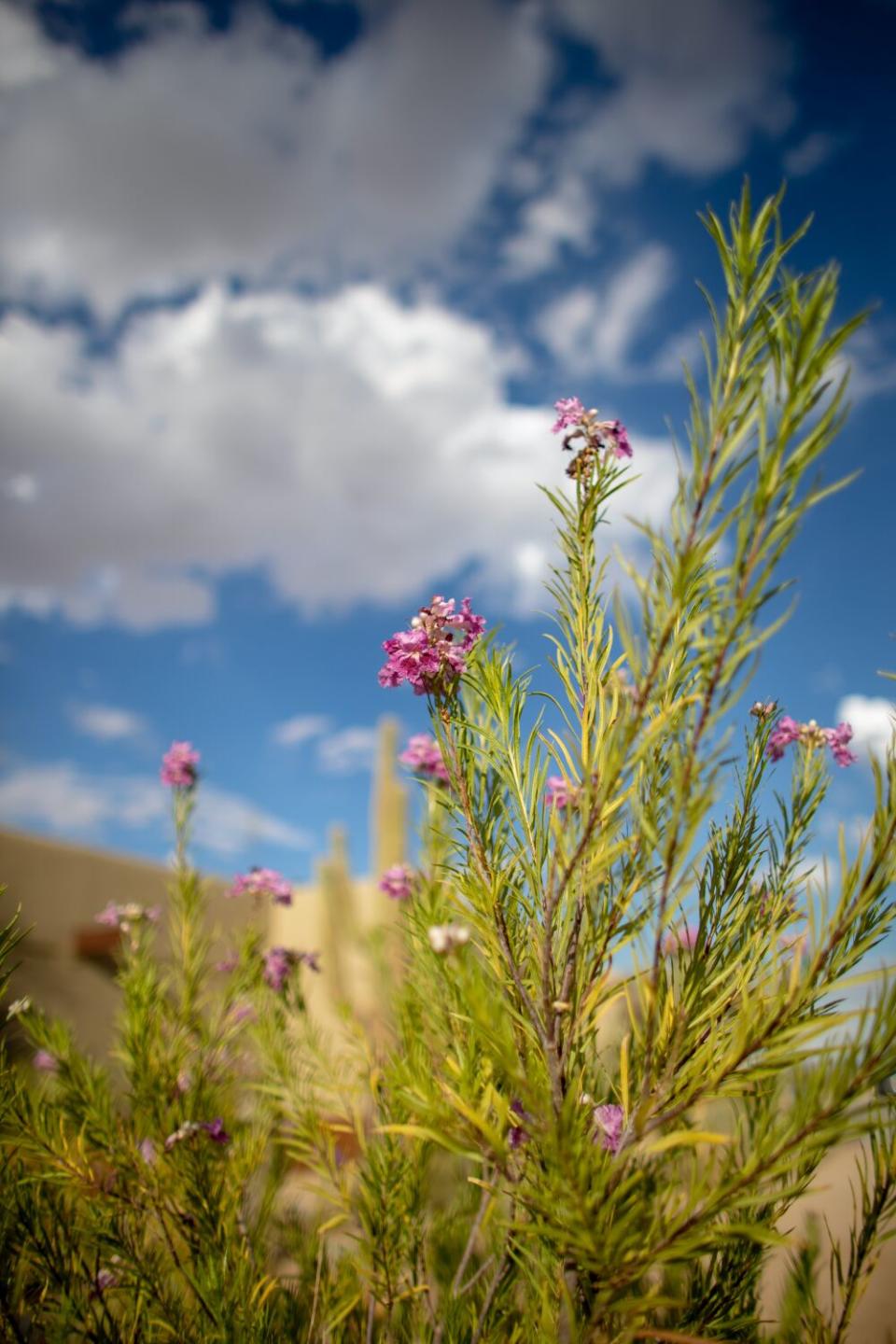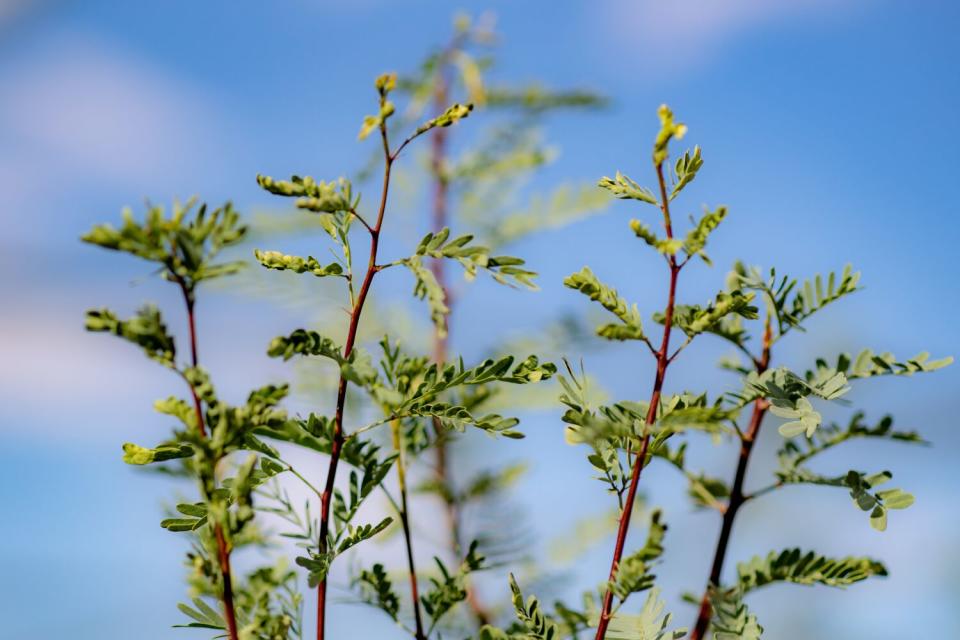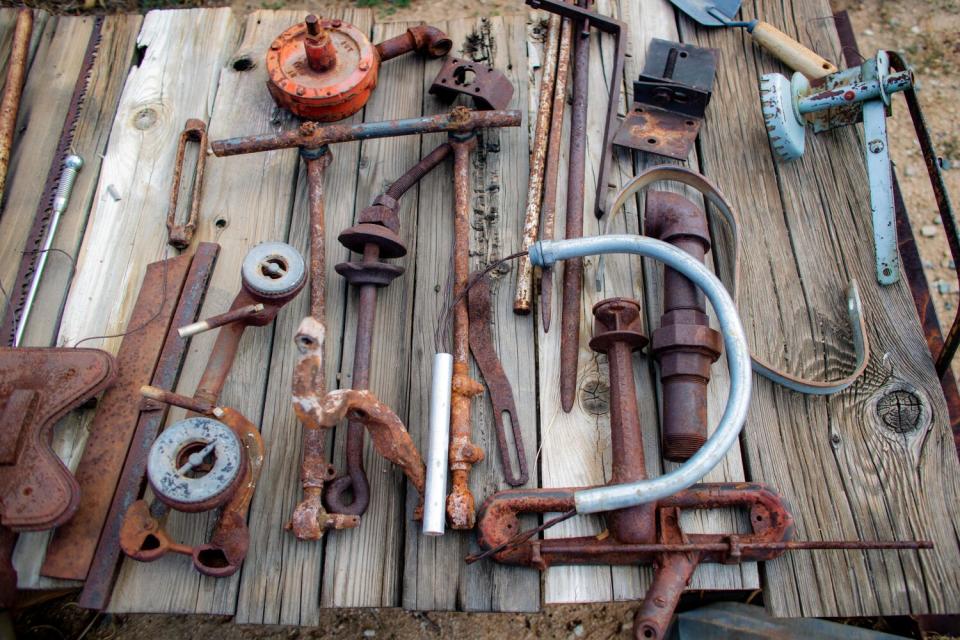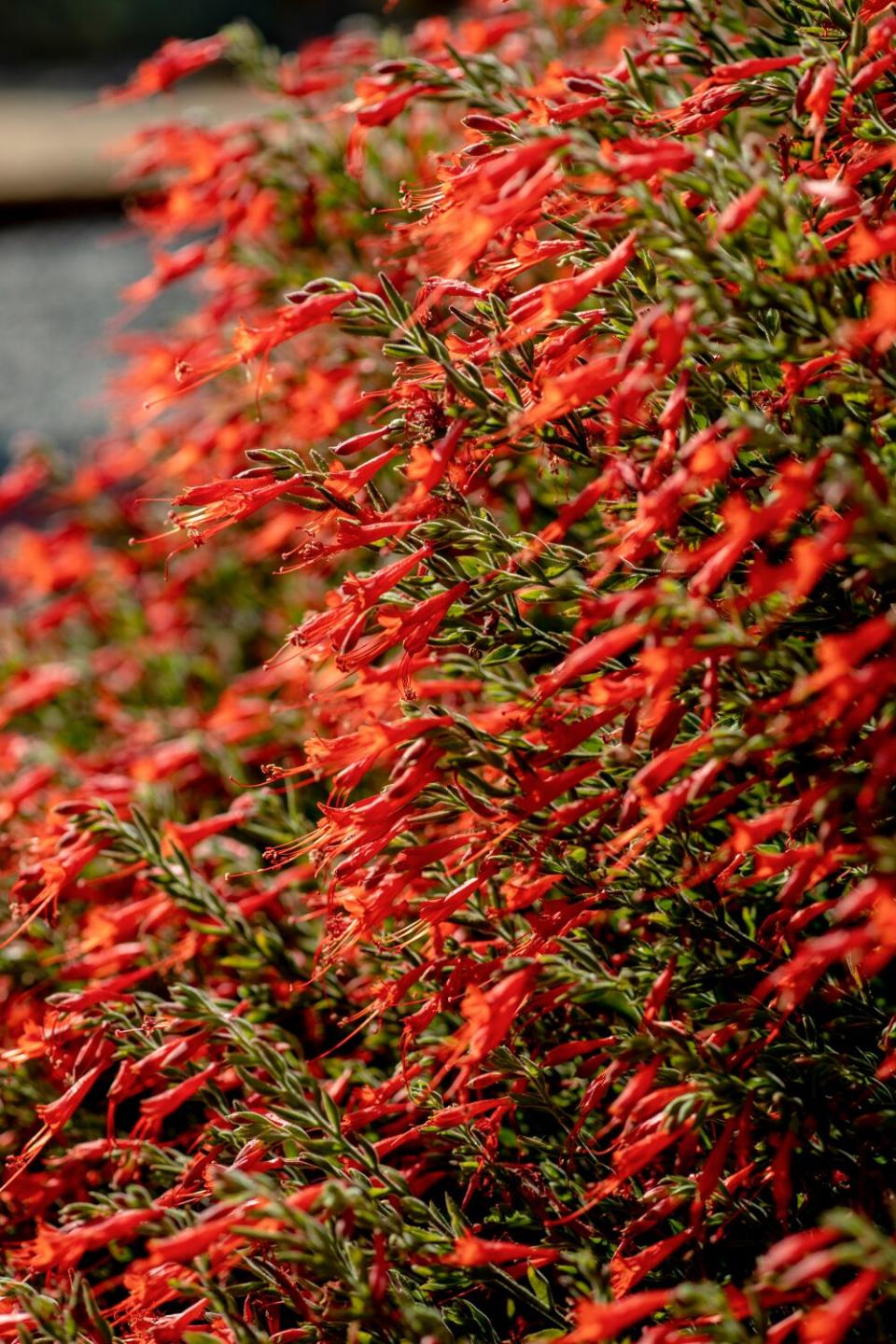Head to Joshua Tree to buy these native plants before they're gone

You'll see it just east of Yucca Valley, along the busy Twentynine Palms Highway, a mysterious sign with four huge red letters — MDLT — underlined by a fat arrow pointing north. It's only when you're closer to the sign that you'll see the illustration of a multi-limbed Joshua tree arcing against a bright blue sky, signaling that you've arrived at the sandy-colored headquarters of the Mojave Desert Land Trust.
You'll need these directions, and an early wakeup call, if you plan to attend the Land Trust's biannual native plant sale on Oct. 8, which features solely plants that grow in the high and low lands of the Mojave Desert. The sale is short — from 9 a.m. to 1 p.m. — but eager buyers start lining up before 8 a.m., said Director of Communications Jessica Dacey, "and when we open the doors, they run."
The sale also includes a few salvage items found on land trust properties, such as an old rusted pickup bed (that took six people to move, Dacey said), an old abandoned metal ice chest and a stack of weathered boards.
The land trust's demonstration garden is open from sunrise to sunset every day for people who want to know what these native shrubs and trees look like when they're older. One of the land trust's main jobs is to purchase small parcels of private land within the desert's national park and preserves, and then convey those lands to the national parks for continued protection. But it also operates a nursery devoted primarily to restoration and preservation work, Dacey said, such as its seed bank with seeds from some 700 plant collections stored in three giant refrigerators, "an insurance policy for the Mojave Desert."
That nursery is closed to the public, but twice a year, in the spring and fall, the land trust provides plants for desert dwellers to buy for their yards, partly as a fundraiser but also to encourage plantings that improve local soils and build habitat.
You'll find several sales for native plants in Southern California this month and next, since late fall and winter are the best time for planting most natives — but the land trust's sale is one of the very few devoted to plants adapted to desert life. It gets hot here (it's the desert, right?), but it also gets very cold, sometimes as low as 20 degrees, said Madena Asbell, the trust's director of plant conservation. These hardy plants have evolved to survive in both extremes.
Some native plants do well throughout the region, such as California buckwheat and the red-throated California fuchsia, but others are less familiar outside of the desert, such as cheesebush (Ambrosia salsola), burro bush or bur-sage (Ambrosia dumosa) and yellow-blooming creosote bush (Larrea tridentata) — the Mojave Desert's ubiquitous and foundational shrub that provides food and shelter to a number of species, including the desert tortoise. It also has a defining characteristic: "The smell of the desert we all think of, that smell after it rains?" Asbell said. "That's the smell of creosote."
The land trust grows its plants from seeds collected on its desert lands, and creosote is slow-growing, so it won't have any of those plants to sell until next year's fall sale, said Asbell, but this year's sale features 50 other species, including rush milkweed (Asclepias subulata) and desert milkweed (Asclepias erosa); desert willows (Chilopsis linearis) with their frilly vanilla-scented blooms; and the delightfully named hole-in-the-sand (Nicolettia occidentalis), a skeletal, bristly-looking plant with bright pink and yellow flowers.
Pollinator alert: Buyers might take home more than a plant if they're lucky. When we toured the headquarters to look at the sale offerings last week, we spied several caterpillars that'll one day become black desert swallowtail butterflies and queen butterflies, an orange cousin of the monarch butterfly that also frequents desert milkweed, Asbell said.

They'll be selling seeds at the sale and some cactus too, Asbell said, such as the lovely silver cholla (Cylindropuntia echinocereus), whose silvery bristles take on an ethereal glow in the setting sun. But Asbell said it's wrong to think of cactuses as the only plants that grow in the desert. Shrubs actually have a much more important role, she said.
"It's perfectly acceptable to plant cactus and succulents to preserve water, but we need native shrubs to enrich the environment," she said. "There's a common misperception that the desert is a wasteland, which it's not. It's a functional, thriving ecosystem and a lot of animals and people depend on this ecosystem to remain healthy, so the more we can do to keep these ecosystems intact and restore them or enhance them, the better."

Asbell said many customers are urban dwellers who have a second home in the desert and are eager to add native plants to their landscapes. But planting in desert soils is different than in L.A., she said, an everything-you-know-is-wrong lesson she had to learn herself when she left her plant conservation job at the Theodore Payne Foundation in Sun Valley to start the plant conservation program at the land trust in 2016.
For instance, she said, the rule of thumb when planting a tree or shrub around Los Angeles is to make the hole wider than the root ball to give the roots plenty of room to settle in. In the desert, she said, it's best to keep the hole just big enough for the root ball to fit and no wider.

"If you dig too wide a hole, the soil you back fill with has been loosened and will dry out faster than the soil around it that's not been disturbed," she said. "So we've learned not to disturb much of the soil around where we need to put the plant in."
The land trust has a desert landscaping guide, lists of plants to attract pollinators and other desert dwellers and a planting guide on its website (while you're on the website, check out the gorgeous land trust posters by L.A. artist Edward Lum as well). Asbell has these additional tips for successful desert planting:
Start with bigger plants. "When I lived in L.A. the rule of thumb (for native plants) was to plant small, the smaller the better," so the plants could really grow into their environment. But even native plants need water when they're getting established, and plants with shallow root systems can't get established "because it's just too dry here." Instead, the land trust sells plants with longer roots in either gallon-size containers or something they call 4-10s, which are 4 inches across at the top but 10 inches long, so the roots are deeper and better established.

Backfill with native soil, never amendments. Desert soils are lean, usually more sand and decomposed granite than the loamy soils we covet in other parts of Southern California, and desert natives have adapted to those dry soils. So adding organic materials like compost or even a wood chip mulch is too rich and moist a diet for these spare plants. "You don't want to add more water than necessary or organic materials to the soil." If you want to provide some shelter for a plant, try moving a boulder or large rock nearby to provide some shade and help preserve moisture in the soil.
Water the hole before adding the plant. Asbell recommends filling the hole at least twice before you put in the plant, to ensure moisture gets down to the roots. And then encircle the plant with a small soil berm to hold water in the future.

Build a simple cage to protect your plant. "You must, must, must cage your plants, because if you don't something will come in the night and disappear your plant." The best cage is easy to build: Just buy a roll of quarter-inch or half-inch hardware cloth, a.k.a. chicken wire, and wrap it around the plant to keep rodents, rabbits and other nibblers from eating it before it can become established. Keep the wire far enough from the plant so it has room to grow without branches protruding through the wire. "You'll need to leave it on for at least a year or two, until the plant puts on enough growth that something can nibble it and not kill the plant."
Water deeply but infrequently. Give the plant a good watering — Asbell recommends about two gallons per plant per watering — and then keep an eye on the weather and water when it's dry. Your schedule will depend on rainfall and the time of year; just be sure when you water that it's enough to get down below the roots.
Bottom line: Adding at least some of these native shrubs to your desert landscape will go a long way to nurturing wildlife and fighting off aridification — the drying out of soils to the point that nothing will grow. "More and more people are moving to this part of the desert, and it's a beautiful place, so they're drawn here for good reasons," Asbell said. "I'm just glad this nursery exists, to offer these plants to people who don't know where else to get them."

If you can't make the sale on Oct. 8, check out these other plant and garden-related activities around Southern California in October. Email events to jeanette.marantos@latimes.com at least three weeks before they happen, and we might include them in the calendar.
Oct. 1-31
Freaky Flora, a free, self-guided tour of the Los Angeles County Arboretum & Botanical Gardens that includes spooky facts about 25 plants, answering questions such as: How did the pomegranate get the name "the fruit of the dead?" Why was rosemary traditionally placed in funeral bouquets? And what herb in the Middle Ages was believed to ward off evil spirits? Participants can download the Freaky Flora plant list from the arboretum's website or using QR codes along the route. (Look for little scarecrows tucked along the paths.) Available 9 a.m. to 5 p.m. at 301 N. Baldwin Ave. in Arcadia. Free with $15 admission to garden ($11 for seniors age 62+ and students with ID, $5 ages 5 to 12, members and children 4 and under enter free). Nonmembers must purchase their tickets online in advance. arboretum.org
Oct. 1-2
Ikebana displays at Descanso Gardens' Japanese Garden, 9 a.m. to 5 p.m. at 1418 Descanso Drive in La Cañada Flintridge, created by the Sogetsu School of Ikebana. The display is free with $15 admission to the garden ($11 seniors 65+ and students with ID, $5 ages 5 to 12, members and children under 5 enter free). descansogardens.org
Oct. 1
The Chino Basin Water Conservation District's Waterwise Garden & Pumpkin Fest is a free, family-oriented event that includes a pumpkin patch, sale of drought-resistant plants and seminars about water conservation and water-wise landscaping from 10 a.m. to 2 p.m. at the district's headquarters, 4594 San Bernardino St. in Montclair. The event also includes stations for creating succulent pumpkin centerpieces and pumpkin painting, as well as food vendors, live entertainment and arts and crafts for children. cbwcd.org
Starting From Seed, a class about starting plants from seed taught by Conor Fitzpatrick at Fig Earth Supply, from 11 a.m. to noon at 3577 N. Figueroa St., in Mount Washington. Tickets are $5, register online. figearthsupply.com
Oct. 6
The Southern California Horticultural Society's monthly meeting includes a guided tour of the new Loran Whitelock Cycad Garden at the Huntington Library, Art Museum, and Botanical Gardens, led by Gary Roberson, lead project gardener, who will also be the featured speaker. The tour and meeting are free to members of the horticultural society and $5 to nonmembers, but advance registration is required since the tour is capped at 60 attendees. Registration closes on Oct. 4. Check-in for the hourlong tour is 5 to 5:20 p.m. at the Huntington's Brody Botanical Center. The meeting begins at 7:20 p.m. socalhort.org
Oct. 7-9
Arroyo Permaculture Convergence, a weekend of hands-on workshops and lectures in Altadena, includes workshops in soil microbiology and composting by soil scientist Lynn Fang, urban food forestry and fruit tree care and pruning by @zerowastefarmer Manju Kumar of the Urban Food Forest and fungal culturing by Paula Peng, co-founder of the L.A. Mushroom Co-op. The event includes two breakfasts and dinners, plus a kickoff potluck dinner on Oct. 7; participants should pack their own lunches. The cost is $200 to $400, depending on income; registration is only by email at arroyopermaculture@gmail.com.
Oct. 8
The Art of Citrus Care and Pruning, a workshop about backyard citrus orcharding by Arlington Garden fruit tree specialist Capri Kasai, using the garden's citrus grove as the classroom, from 9 to 11 a.m. at 275 Arlington Drive in Pasadena. The workshop includes a 30-minute lecture about citrus tree care followed by 90 minutes of hands-on pruning instruction. The cost is $25 per person. The workshop is not suitable for children; participants should be prepared to get dirty and wear sturdy shoes, gloves and long sleeves. The cost is $25 per person, pay at the garden. arlingtongardenpasadena.org
Poly/Ana presents Fall Native Plant Garden Maintenance, a hands-on workshop taught by Max Kanter of Saturate native landscape maintenance, from 9 to 12:30 p.m. in Pasadena. Participants will review the basics of native garden prep for the fall planting season and winter rains. The $40 fee includes lunch. Register online; the location of the workshop will be emailed to participants three days prior to the event. Poly/Ana is the nonprofit arm of the Studio Petrichor landscaping firm, focused on community service and education. eventbrite.com
Fall Gardening, an hourlong class about growing a fall and winter garden including choosing the right plants, seeds and cover crops, from 11 a.m. to noon at Fig Earth Supply nursery, 3577 N. Figueroa St., in Mount Washington. Tickets are $5, register online. figearthsupply.com.
Crescent Farm: Heirlooms, a class at the Los Angeles County Arboretum and Botanic Garden's Crescent Farm from 10 a.m. to noon about the advantages and disadvantages of growing heirloom fruit and vegetables. The class, taught by professional edible-plant gardener Loretta Allison and Crescent Farm employee John Latsko, will describe what heirloom varieties are and where to find heirloom seeds. The class is free with $15 admission to the garden ($11 for seniors age 62+ and students with ID, $5 ages 5 to 12, members and children 4 and under enter free.) Nonmembers must purchase their tickets online in advance. arboretum.org
Oaks of L.A.: An Arborist’s Perspective with TreeCareLA, is a class about the care of Los Angeles’ urban canopy of native trees, 9 a.m. to noon at the Theodore Payne Foundation, 10459 Tuxford St. in Sun Valley. The class includes a tree walk and talk through the foundation’s grounds and time for questions and answers. Register online, $48 ($40 for members). eventbrite.com
Oct. 14-16
The Huntington Library, Art Museum, and Botanical Gardens' 6th International Orchid Show and Sale, 10 a.m. to 5 p.m. at the Huntington's Brody Botanical Center, 1151 Oxford Road in San Marino. The show includes exhibitors from 14 orchid societies in California and Las Vegas and 15 vendors from California, Michigan, Ecuador, Peru and Thailand. Free with $29 admission to the gardens (seniors 65+, military and students with ID $24, $13 ages 4 to 11, free for members and children under 4.) Reservations required for weekend entry. huntington.org
Oct. 15-16
California Botanic Garden Grow Native Nursery Fall Plant Sale at the nursery of the state's largest botanic garden devoted to California native plants, 1500 N. College Ave. in Claremont. The sale is open to members only from 8 to 10 a.m. on Oct. 15 and open to everyone from 10 a.m. to 4 p.m. Oct. 15-16. The nursery has been closed most of the year after a huge windstorm felled trees and damaged other parts of the garden in February. A list of the plants available for purchase will be online starting Oct. 14. Members get 10% off purchases. calbg.org
Oct. 15-16, 29-30
Bonsai Academy Series at the Huntington Library, Art Museum, and Botanical Gardens, an intensive four-session gakko or school in the art of bonsai, taught by bonsai master Ted Matson at the Huntington's Education and Visitor Center, 1151 Oxford Road in San Marino. The four daylong classes (10 a.m. to 4 p.m.) are geared toward beginners and include the history of bonsai, basic tree botany and horticultural challenges, design concepts, training techniques and bonsai display. All supplies and tools are provided, including demonstration trees for classroom practice. Registration includes admission to the Huntington after the class. Tickets are $200, or $180 for members. huntington.org
Oct. 15
Walnut Valley Water District hosts a workshop on landscaping to protect against wildfire, by landscape architect Douglas Kent, author of "Firescaping: Protecting Your Home With a Fire-Resistant Landscape," from 11 a.m. to noon at the Diamond Bar Center, 1600 Grand Ave. in Diamond Bar. Tickets are free but registration is required. wvwd.com
Los Angeles Community Garden Council's 2022 Gathering of Community Gardens: A Celebration of Regeneration will focus on environmental issues and sustainability best practices, with Los Angeles Times columnist Gustavo Arellano as the featured speaker, from 9 a.m. to 1 p.m. at the Solano Canyon Community Garden, 545 Solano Ave. in Elysian Park. The Community Garden Council will conduct tours of the Solano Canyon garden and provide information about composting, best watering practices and other regeneration practices. Expect lunch and live jazz and blues music by the Solid Senders, along with classes for children to make seed bombs. Participants are asked to bring their own plate, cup and eating utensils to this no-waste event. The suggested donation is $15 to cover the cost of lunch, but no one will be denied due to lack of funds. eventbrite.com
Fruit Tree 101 with Fruitstitute, taught by Fruitstitute founder Joanna Glovinsky, from 11 a.m. to noon at Fig Earth Supply, 3577 N. Figueroa St. in Mt. Washington. Glovinsky will discuss why commercially cultivated species of fruit trees are different from other trees and the basics of fruit tree care, including feeding, pruning and managing fruit production. Register online; tickets are $10. figearthsupply.com
Playing in the Dirt: Soil Exploration Workshop for Kids, 10 to 11 a.m. at South Coast Botanic Garden, 26300 Crenshaw Blvd., in Rolling Hills Estates, an interactive class geared toward pre-kindergarten that teaches children about the importance of soil health and introduces them to a "squirm" of worms. At least one parent must be present during the entire class. Tickets are $40 and include admission for one child and one parent. Tickets for additional children are $20. southcoastbotanicgarden.org
Oct. 16
Potions Class: How to Grow a Cocktail-Inspired Garden, 2 to 4 p.m. at South Coast Botanic Garden, 26300 Crenshaw Blvd. in Rolling Hills Estates, a class taught by Terry Huang, the garden's director of living collections, that includes instructions for growing herbs that can be made into syrups and infusions for cocktails and mocktails. The class will be held outdoors; tickets are $50 ($40 for members). southcoastbotanicgarden.org
Oct. 22-23
Orange County Chrysanthemum Society's 2022 Chrysanthemum Show & Sale 10:30 a.m. to 4 p.m. at Sherman Library & Gardens, 2647 East Coast Hwy. in Corona del Mar. The event includes a limited plant sale — arrive early for best selection. Renee Wherley, president of the San Gabriel Valley Chrysanthemum Society, will give a free introduction to chrysanthemums talk at 11:30 a.m. on Oct. 22, and chrysanthemum society member Norm Nakanishi will offer advice about growing chrysanthemums in pots for exhibition at 11:30 a.m. on Oct. 23. Admission to the show is free with $5 entry to the garden; members and children 3 and younger enter free. thesherman.org
Oct. 22
Mulch Giveaway at Descanso Gardens, 8 to 10 a.m. at 1418 Descanso Drive in La Cañada Flintridge. The garden's horticulture staff will be available to answer questions about mulching. Participants should bring their own containers, maximum of three containers per household. Supplies are limited, so first come, first served. The garden is looking for a limited number of volunteers to help with passing out the mulch and offer tips in water-wise gardening. Advance registration is required. descansogardens.org
Oct. 28-29
Issues With Oaks: A Tree Walk and Talk at the Theodore Payne Foundation with the foundation’s consulting arborist Alison Lancaster, who will guide participants through evaluations of oak trees on the grounds to identify nonharmful native insects, destructive invasive pests, diseases that cause health and structural problems in oaks and other issues. The Oct. 28 class is 1 to 3 p.m. and the Oct. 29 class is 9 to 11 a.m. Both classes are at the Theodore Payne Foundation grounds,10459 Tuxford St. in Sun Valley. Register online, tickets are $35 ($25 for members). eventbrite.com
Oct. 30
Finding Our Way Home With Fungi, a Theodore Payne Foundation walk and talk about mushrooms led by Aaron Tupac-Thompson, a member of the Los Angeles Mycological Society board of directors. Thompson, creator of the Exploring the Mycoverse community education group, will lead a two-hour walk on an easy-moderate unpaved path in Altadena looking for mushrooms along the river banks of the Arroyo Seco. Participants should wear closed-toed shoes and bring water and sun protection. The exact location of the walk will be emailed to participants. Tickets are $35 ($25 for Theodore Payne Foundation members). eventbrite.com
This story originally appeared in Los Angeles Times.

